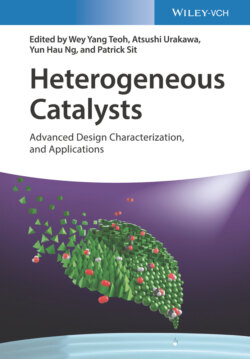Читать книгу Heterogeneous Catalysts - Группа авторов - Страница 51
4.2.3 Catalyst on Nanodiamonds and Onion‐Like Carbon
ОглавлениеNanodiamonds are diamonds (carbon allotrope with sp3 hybridization) of 2–5 nm found in meteorites and interstellar dust [23]. Recently, nanodiamonds have been produced synthetically in the form of films and powders. A large quantity of nanodiamond powder has been successfully synthesized by the detonation of explosive carbonaceous mixture. In fact, carbon atoms in nanodiamonds do not have a purely diamond structure, rather they have an intermediary structure with sp2 and sp3 character, with a diamond‐like core covered by an outer shell of graphitic/amorphous carbon (Figure 4.3). High‐temperature annealing (>1750 °C) of nanodiamonds could transform them into “carbon nano‐onions” (Figure 4.3a). Annealing at lower temperatures gives rise to intermediate sp3@sp2 core–shell structures. The outer graphitic layer is amenable to functionalization and doping, which has been exploited to prepare metal‐free catalysts in several reactions. Moreover, nanodiamonds have been used as metal catalyst support, and the following paragraphs describe more in detail some of the few preparations of catalysts supported on nanodiamonds. As explained, annealing of nanodiamonds at increasing temperatures increases the thickness of the graphitic shell, ultimately transforming them into onion‐like carbon (OLC). By exploiting this concept, some researchers prepared intermediate nanodiamond core/graphitic shells (ND@G) and OLC. Pt nanoparticles (<2 nm) were deposited by incipient wetness impregnation on both supports, and Pt/ND@G exhibited higher turnover rate in CO catalytic oxidation compared to Pt/OLC and Pt/Al2O3 [25]. Moreover, they were tested in propane dehydrogenation at 600 °C. Under this demanding reaction condition, Pt/ND@G was shown to be significantly more stable than Pt/Al2O3, and its stability was attributed to the donation of electron density from the support to the metal (strong metal–support interaction [SMSI]), leading to less crystalline nanoparticles. Due to SMSI, sintering of the metal is prevented and formation of coke is decreased due to the enhanced desorption of propylene. One of the disadvantages of nanodiamonds is that they tend to form aggregates (up to 200 nm). Aggregation can be overcome by dispersing and stabilizing nanodiamonds on a support such as the formation of hybrids with graphene [26].
Figure 4.3 (a) Gradual transformation of nanodiamond to onion‐like carbon at increasing annealing temperatures. (b) Schematic representation of nanodiamond.
Source: Zeiger et al. 2016 [24]. Reprinted with permission of Royal Society of Chemistry.
